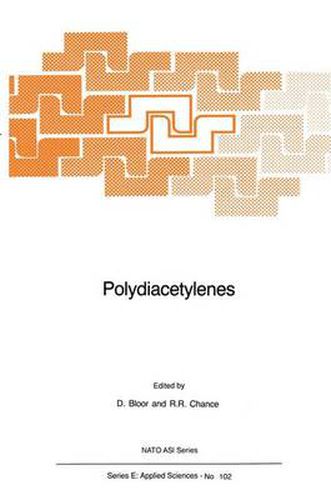Readings Newsletter
Become a Readings Member to make your shopping experience even easier.
Sign in or sign up for free!
You’re not far away from qualifying for FREE standard shipping within Australia
You’ve qualified for FREE standard shipping within Australia
The cart is loading…






This title is printed to order. This book may have been self-published. If so, we cannot guarantee the quality of the content. In the main most books will have gone through the editing process however some may not. We therefore suggest that you be aware of this before ordering this book. If in doubt check either the author or publisher’s details as we are unable to accept any returns unless they are faulty. Please contact us if you have any questions.
The polydiacetylenes are a class of polymers that are attrac ting increasing attention worldwide. There are many reasons for this interest one of the most important being the availability of many polydiacetylenes as macroscopic, high quality, single crystals. This fact was first reported in the pioneering work of Prof. G. Hegner on the solid-state polymerization of disub stituted diacetylenes in the late 1960s. Since then studies of the polymerization process and the properties of monomers and polymers have advanced understanding of solid-state reactivity and the physiCS of quasi-one-dimensional materials. More recently work on soluble polydiacetylenes, gels and films has been of interest for both academic and technological reasons. Progress in this area has required a combination of research disciplines ranging from synthetic organic chemistry to solid state physics. The interdisciplinary effort required for success ful research in polydiacetylenes was reflected in the mix of chemists, physicists and materials scientists who attended the Workshop. The emerging potential for commercial applications of polydiacetylenes was also evident in the nearly equal partici pation of academic and industrial/government scientists. The WOrkshop was the first major international meeting to focus solely on polydiacetylenes. It provided a forum in which problems of mutual interest could be discussed by scientists with diverse backgrounds and interests. It also satisfied the need for a review of the science of these materials at a time when this basic understanding is leading to technological applications.
$9.00 standard shipping within Australia
FREE standard shipping within Australia for orders over $100.00
Express & International shipping calculated at checkout
This title is printed to order. This book may have been self-published. If so, we cannot guarantee the quality of the content. In the main most books will have gone through the editing process however some may not. We therefore suggest that you be aware of this before ordering this book. If in doubt check either the author or publisher’s details as we are unable to accept any returns unless they are faulty. Please contact us if you have any questions.
The polydiacetylenes are a class of polymers that are attrac ting increasing attention worldwide. There are many reasons for this interest one of the most important being the availability of many polydiacetylenes as macroscopic, high quality, single crystals. This fact was first reported in the pioneering work of Prof. G. Hegner on the solid-state polymerization of disub stituted diacetylenes in the late 1960s. Since then studies of the polymerization process and the properties of monomers and polymers have advanced understanding of solid-state reactivity and the physiCS of quasi-one-dimensional materials. More recently work on soluble polydiacetylenes, gels and films has been of interest for both academic and technological reasons. Progress in this area has required a combination of research disciplines ranging from synthetic organic chemistry to solid state physics. The interdisciplinary effort required for success ful research in polydiacetylenes was reflected in the mix of chemists, physicists and materials scientists who attended the Workshop. The emerging potential for commercial applications of polydiacetylenes was also evident in the nearly equal partici pation of academic and industrial/government scientists. The WOrkshop was the first major international meeting to focus solely on polydiacetylenes. It provided a forum in which problems of mutual interest could be discussed by scientists with diverse backgrounds and interests. It also satisfied the need for a review of the science of these materials at a time when this basic understanding is leading to technological applications.